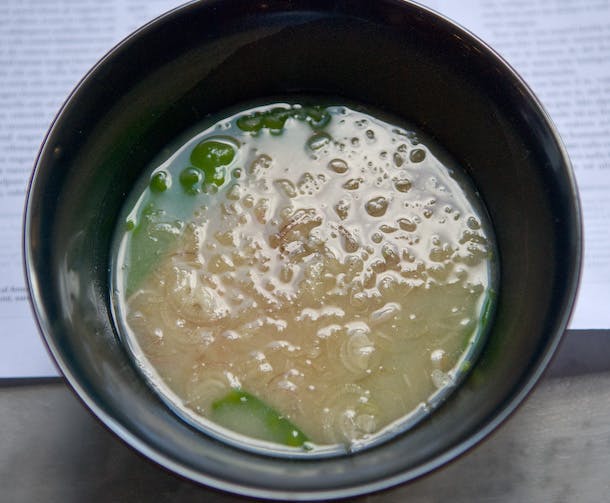
Konbu Dashi Miso Soup with Snow Peas
Atsushi's simple soup recipe demonstrates the concept of mottainai by using turnip peels and scrap pieces of carrot to create a flavorful broth with the power of konbu. The addition of snow peas, sweet white miso, and awase miso results in a pleasing umami flavor, showcasing the depth and versatility of this traditional Japanese ingredient.
A simple soup that evokes the ideas of mottainai and the power of konbu: Chef Atsushi Nakahigashi collected turnip peels and scrap pieces of carrot from preparing other dishes and added them to a pot of water with a piece of konbu in it. He turned on the heat and cooked it until the konbu gave off a pleasing aroma, then strained the liquid. In the meantime, Atsushi sliced a handful of snow peas on the diagonal. He added them to the strained broth and simmered until the peas cooked through. Now he dissolved sweet white miso (Kyoto is famous for its saikyo white miso) and a bit of awase miso, a mixture of red and white miso, to add a touch of saltiness. He tasted, as always, and when the soup had a pleasing miso flavor, but not overpowering, he ladled it into bowls to serve and garnished with thinly sliced, aromatic myoga.
While this soup was probably the simplest one Atsushi prepared during his stay, it again demonstrates how profound an ingredient konbu really is. This kelp, which as been used as an ingredient in Japan for over a thousand years, can instantly transform something as basic as vegetable scraps boiling in water into something savory and deep because it's so rich in umami. Umami, of course, is found in other ingredients, like tomatoes, cheese and the sauce reductions that are fundamental to French cuisine. But nothing can boost flavor as subtly and sublimely -- and with a much, much lighter touch -- than konbu.
